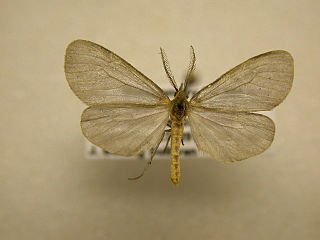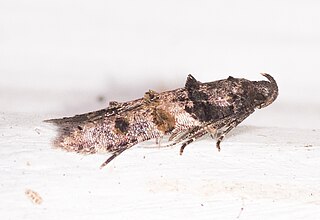
Pagara is a monotypic moth genus in the family Erebidae. Its only species, Pagara simplex, the mouse-colored lichen moth, is found in North America, where it has been recorded from Alabama, Arkansas, Florida, Georgia, Illinois, Indiana, Iowa, Kansas, Kentucky, Maryland, Mississippi, New Hampshire, North Carolina, Ohio, Oklahoma, South Carolina and Tennessee. Both the genus and species were described by Francis Walker in 1856.

Walshia is a genus of moths in the family Cosmopterigidae.

Sphenarches anisodactylus, commonly known as the geranium plume moth, is a species of moth in the family Pterophoridae. It is found in western Africa, Madagascar, India, Sri Lanka, Thailand, Japan, the New Hebrides and Central and South America, as well as Australia, where it has been recorded from Cape York to central New South Wales. It is found in the United States, where it has been recorded from Florida, as well as Mississippi. It is also present in the Kermadec Islands of New Zealand.

Adaina bipunctatus is a moth of the family Pterophoridae. It is found in the United States, including Florida and Mississippi. It has also been recorded from Trinidad, the West Indies, Brazil and Ecuador.

Hellinsia paleaceus is a moth of the family Pterophoridae described by Philipp Christoph Zeller in 1873. It is found in North America, including Florida, Mississippi Maryland, Montana, Texas, California, Nebraska, New Mexico and south-eastern Canada. It has also been recorded from Puerto Rico.
The Chrysopeleiinae are a subfamily of the Cosmopterigidae, although some authors treat it as a full family, the Chrysopeleiidae.
Homaledra sabalella, the palm leaf skeletonizer moth, is a moth in the family Pterolonchidae. It is found in North America, where it has been recorded from Alabama, Florida, Mississippi, South Carolina and Texas. It is also present in Puerto Rico, Hispaniola and Cuba.
Walshia albicornella is a moth in the family Cosmopterigidae. It was described by August Busck in 1914. It is found in Panama.
Walshia amorphella is a moth in the family Cosmopterigidae. It was described by James Brackenridge Clemens in 1864. It is found in North America, where it has been recorded from Illinois, Iowa, Kentucky, Minnesota and from Kansas to Texas.
Walshia calcarata is a moth in the family Cosmopterigidae. It was described by Lord Walsingham in 1909. It is found in Mexico.
Walshia detracta is a moth in the family Cosmopterigidae. It was described by Lord Walsingham in 1909. It is found in Mexico.
Walshia dispar is a moth in the family Cosmopterigidae. It was described by Ronald W. Hodges in 1961. It is found in North America, where it has been recorded from Ontario to Virginia.
Walshia elegans is a moth in the family Cosmopterigidae. It was described by Ronald W. Hodges in 1978. It is found in North America, where it has been recorded from Florida, Louisiana, Arkansas, Iowa and West Virginia.
Walshia exemplata is a moth in the family Cosmopterigidae. It was described by Ronald W. Hodges in 1961. It is found in North America, where it has been recorded from Maryland, Arkansas, Indiana, Ohio, West Virginia, South Carolina, Mississippi, Louisiana and Florida.

Walshia miscecolorella, the sweetclover root borer moth, is a moth in the family Cosmopterigidae. It was described by Vactor Tousey Chambers in 1875. It is found in North America, where it has been recorded from southern Canada south to Florida and Texas.
Walshia pentapyrga is a moth in the family Cosmopterigidae. It was described by Edward Meyrick in 1922. It is found in Brazil.
Walshia similis is a moth in the family Cosmopterigidae. It was described by Ronald W. Hodges in 1961. It is found in North America, where it has been recorded from Massachusetts, Michigan and from Illinois to South Carolina and Florida.
Walshia floridensis is a moth in the family Cosmopterigidae. It was described by Ronald W. Hodges in 1978. It is found in North America, where it has been recorded from Florida.
Nites betulella, the black-dotted birch leaftier moth, is a moth in the family Depressariidae. It was described by August Busck in 1902. It is found in North America, where it has been recorded from Nova Scotia, southern Canada, the north-eastern United States, British Columbia and Wisconsin.

A MONA number, or Hodges number after Ronald W. Hodges, is part of a numbering system for North American moths found north of Mexico in the Continental United States and Canada, as well as the island of Greenland. Introduced in 1983 by Hodges through the publication of Check List of the Lepidoptera of America North of Mexico, the system began an ongoing numeration process in order to compile a list of the over 12,000 moths of North America north of Mexico. The system numbers moths within the same family close together for identification purposes. For example, the species Epimartyria auricrinella begins the numbering system at 0001 while Epimartyria pardella is numbered 0002.






